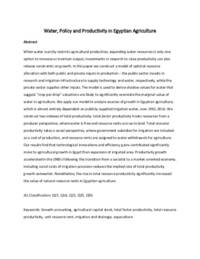Water, Policy, and Productivity in Egyptian Agriculture

Authors:
When water scarcity restricts agricultural production, expanding water resources is only one option to
increase or maintain output; investments in research to raise productivity can also release constraints
on growth. In this paper, we construct a model of optimal resource allocation with both public and private inputs in production—the public sector invests in research and irrigation infrastructure to supply
technology and water, respectively, whereas the private sector supplies other inputs. The model is used
to derive shadow values for water that suggest “crop per drop” valuations are likely to significantly
overstate the marginal value of water in agriculture. We apply our model to analyze sources of growth
in Egyptian agriculture, which is almost entirely dependent on publicly supplied irrigation water, over
1961–2016. We construct two indexes of total productivity: total factor productivity treats resources
from a producer perspective, where water is free and resource rents accrue to land. Total resource productivity takes a social perspective, where government subsidies for irrigation are included as a cost of
production, and resource rents are assigned to water withdrawals for agriculture. Our results find that
technological innovations and efficiency gains contributed significantly more to agricultural growth in
Egypt than expansion of irrigated area or water use. Productivity growth accelerated in the 1980s following the transition from a socialist to a market-oriented economy. Including social costs of irrigation
provision reduces the implied rate of total productivity growth only marginally. Nonetheless, the rise in
total resource productivity significantly increased the value of natural resource rents in Egyptian
agriculture.
